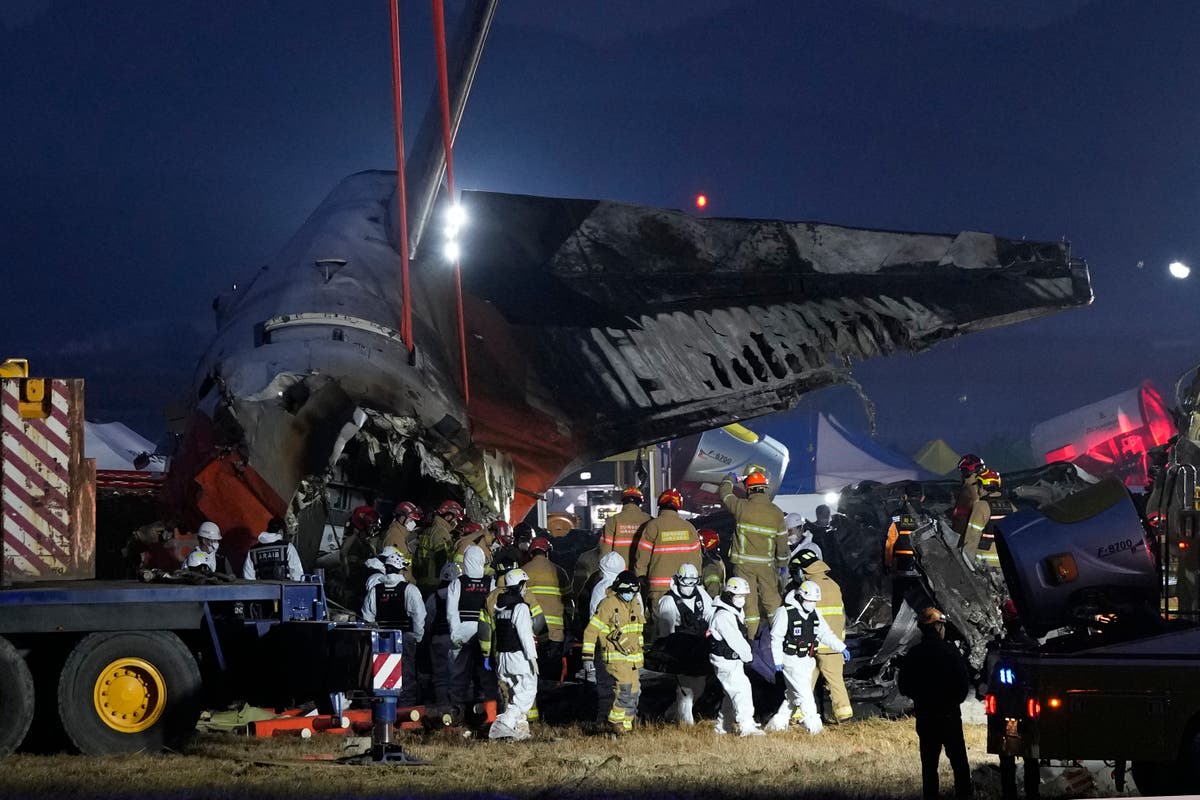South Korea has vowed thorough investigations to find what caused a plane crash that killed 179 people, saying Monday that it will also inspect all Boeing 737-800 aircraft operated by the country’s airlines.
Sunday’s crash, the nation’s deadliest aviation disaster in decades, has sent a shock wave through South Korean society, which is already facing a political crisis that led to the successive impeachments of the country’s top two officials — President Yoon Suk Yeol and Prime Minister Han Duk-soo.
Here are things to know about developments on the crash.
__
What happened and what might have caused it?
Jeju Air flight 7C 2216 had departed from Bangkok and was making its landing at Muan International Airport in southern South Korea. After an initial failed landing attempt, the Boeing 737-800 plane received a bird strike warning from the ground control center. The pilot then issued a distress signal before the plane came down with its front landing gear closed, overshot the runway, slammed into a concrete fence and burst into a fireball.
Observers say videos of the crash showed the plane was suffering from suspected engine trouble, but the landing gear malfunction was likely the main reason for the crash.
South Korean Transport Ministry officials said Monday they will examine whether the fence the plane hit — which housed a set of antennas designed to guide aircraft safely during landings — should have been made with lighter materials that would break more easily upon impact. They said they were also trying to establish whether there were any communication problems between air traffic controllers and the pilot.
Ministry officials said Monday the plane’s flight data and cockpit audio recorders were moved to a research center at Seoul’s Gimpo International Airport ahead of their analysis. Ministry officials earlier said it would take months to complete the investigation of the crash.
Does the crash represent another setback for Boeing?
The crash wrapped up a troubling 2024 for U.S. aviation giant Boeing, which has grappled with safety problems, a machinists strike and plunging stock prices.
Experts say the 737-800 aircraft is a more proven model than the company’s much-maligned 737 Max jetliners, which were linked to fatal crashes in 2018 and 2019. Still, South Korean authorities said they’ll conduct safety inspections on all of the 737-800s operated by domestic airlines, including 39 by Jeju Air.
Representatives from Boeing and the U.S. National Transportation Safety Board were to travel to Seoul to participate in the South Korean investigation.
On Monday, another Boeing 737-800 plane operated by Jeju Air returned to the Gimpo airport shortly after takeoff when the pilot detected a landing gear issue. Jeju Air said the issue was resolved through communication with a land-based equipment center but the pilot decided to return to Gimpo as a precautionary measure.
What do we know about the victims?
Only two people — both crew members — survived. They were rescued from the plane’s tail section, the only part of the aircraft that remained relatively intact after the crash.
One of the survivors was treated for fractures to his ribs, shoulder blade and upper spine. Ju Woong, director of the Ewha Womans University Seoul Hospital who treated him, said the man told doctors he “woke up to find (himself) rescued.”
The passengers were predominantly South Korean, although they included two Thai nationals.
The Transport Ministry said Monday that authorities have identified 146 bodies and are collecting DNA and fingerprint samples from the other 33.
Park Han Shin, a representative of the bereaved families, said they were told that the bodies of their loved ones were so badly damaged that officials need time before returning them to their families. He called for the government to mobilize more personnel.
Will South Korea’s political crisis affect its handling of the aftermath?
The crash caps a tumultuous month for South Korea that began with Yoon’s extraordinary but short-lived martial law imposition. Following that, the opposition-led legislature voted to impeach Yoon and then his replacement, Han. Deputy Prime Minister Choi Sang-mok is now the country’s acting president.
Also, the safety minister resigned and the police chief was arrested over their roles in the declaration of martial law. The absence of the top officials directly responsible for handling disasters has caused concerns among many people.
Choi quickly traveled to the crash site, met bereaved families and presided over emergency meetings to discuss the incident.
On Monday, Choi instructed authorities to conduct an emergency review of the country’s overall aircraft operation systems. He said that South Korea should use the crash as a chance to formulate steps to prevent the recurrence of similar disasters and build a safer country.
What has reaction been from around the world?
World leaders expressed their sympathies as South Korea dealt with the tragedy.
Thailand’s prime minister, Paetongtarn Shinawatra, expressed deep condolences to the families and ordered the country’s Ministry of Foreign Affairs to provide assistance immediately.
U.S. President Joe Biden issued a statement saying he was “deeply saddened” by the tragedy.
“As close allies, the American people share deep bonds of friendship with the South Korean people and our thoughts and prayers are with those impacted by this tragedy. The United States stands ready to provide any necessary assistance,” he said.
The office of United Nations Secretary-General Antonio Guterres said he extends his “heartfelt condolences to the families of the victims and expresses his solidarity with the people and Government of the Republic of Korea during this difficult time.”
Pope Francis offered condolences from St. Peter’s Square, while Japanese Prime Minister Shigeru Ishiba said he was “deeply saddened by the loss of many precious lives.”
